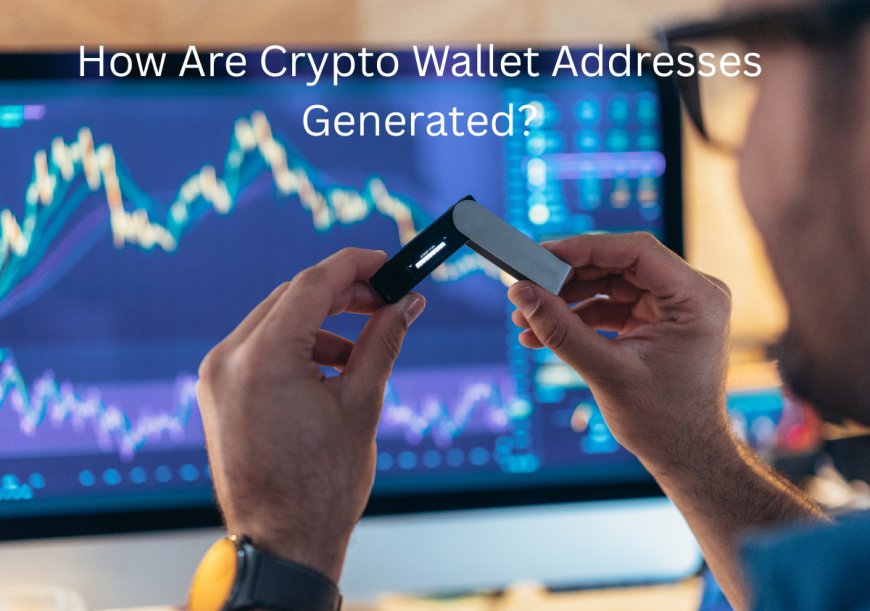How Are Crypto Wallet Addresses Generated?
Discover how crypto wallet addresses are generated using private keys, encryption, and blockchain protocols. Learn the tech behind your wallet identity.

Have you ever wondered, "How is my crypto wallet address created?" You are not alone. Understanding Bitcoin or Ethereum wallet address generation could help one learn more about protecting their digital property and enhance their confidence in using DeFi tools.
Let’s break it down in simple, clear terms—no technical jargon, just practical knowledge.
What Is a Crypto Wallet Address?
A crypto wallet address is a unique identifier that allows you to send and receive cryptocurrency on a blockchain network. Think of it like your bank account number—but for Bitcoin, ETH, or other tokens.
Each address is created from a public key corresponding to a private key. These keys are also called key pairs and are used to protect your funds through cryptography.
It All Starts With the Private Key
Every crypto wallet starts with the generation of a private key. A private key is a large random number generated using cryptographically secure methods. Think of this private key as the master password that allows access to your wallet and all the assets stored therein.
Private keys should never be shared. If anyone else gets hold of it, that person will have full access to your crypto. Many investors use a hardware wallet like Ledger to keep their crypto safe.
From Private Key to Public Key
Once the private key is generated, a public key is mathematically derived from it. This is done through public-key cryptography, which ensures the public key can be shared but cannot be mathematically reversed.
The public key is what allows others to send you digital assets without putting your security at risk.
Creating the Wallet Address
Here’s how the crypto wallet address is generated from the public key:
- Hashing: The public key is hashed using cryptographic algorithms like SHA-256 and RIPEMD-160.
- Encoding: The hashed key is encoded into a readable format like Base58Check for Bitcoin or hexadecimal for Ethereum.
- Prefixing: Each blockchain adds a prefix to the address. For example:
- Bitcoin wallet addresses may start with “1,” “3,” or “bc1.”
- Ethereum addresses always start with “0x.”
The result is your wallet address, which is ready for use in the blockchain ecosystem.
Are All Wallets the Same?
Nope. Different cryptocurrency wallets use different systems:
- Bitcoin wallets may generate SegWit or legacy addresses.
- Ethereum wallets support both ETH and ERC-20 tokens with the same address format.
- Web3 wallets like MetaMask allow users to interact with decentralized applications (dApps) using the same address across multiple networks.
Some wallets are hierarchical deterministic (HD), meaning they can generate multiple addresses from one seed phrase—a list of 12 to 24 words that acts as a backup for your entire wallet.
Software vs. Hardware Wallet Generation
- Software wallets (like Trust Wallet, Plus Wallet, or MetaMask) generate your address during setup using random number generation and your seed phrase.
- Hardware wallets (like Ledger) perform this process offline, protecting your private keys and crypto assets.
When you set up a new wallet, you’re often asked to write down your seed phrase. This phrase is the key to restoring your wallet if you ever lose your phone, computer, or device. Keep it private and offline.
Security Considerations
When dealing with crypto wallet addresses, remember:
- Never share your private keys or seed phrase.
- Double-check addresses using a QR code to avoid typos.
- Use a trusted wallet with strong security practices.
- Store your recovery phrase in a safe place, offline and out of sight.
Tools like CoinLedger help you track transactions tied to your BTC, ETH, or ERC-20 tokens, making it easier to manage taxes and compliance without exposing sensitive information.
Final Thoughts
Knowing how a crypto wallet address is generated empowers you to manage your cryptocurrency more confidently. The entire process is built on strong cryptographic foundations that protect your assets, from public-key cryptography to blockchain standards.
Whether using Bitcoin, Ethereum, or exploring Web3 apps, your wallet address is your gateway to the decentralized world. Guard it well, understand how it’s made, and you’ll be far ahead in your crypto journey.
Want to learn more about how to find your crypto wallet address or which wallet suits your needs best? Let’s dive into that next.
FAQs
Is my wallet address unique?
Yes. Thanks to cryptographic randomness, the chance of two people getting the same address is virtually zero.
How do I find my crypto wallet address?
Simply open your wallet app, tap “Receive,” and you’ll see your address. Most wallets also show a QR code for easy sharing.
I lost my wallet—can I get my address back?
Yes, but only if you have your seed phrase. Without it, your wallet and the digital assets could be lost forever.






















































































































































